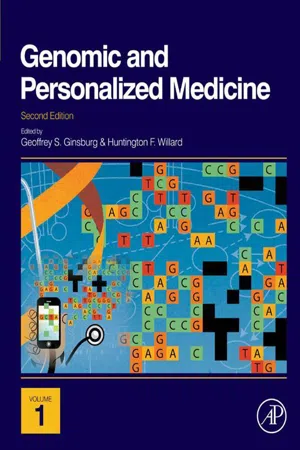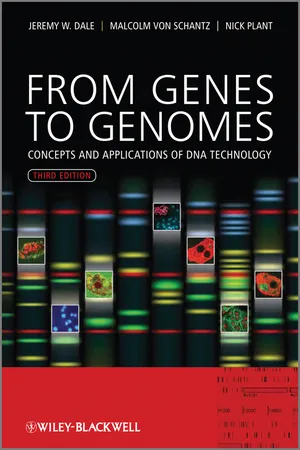Chemistry
DNA Variant
A DNA variant refers to a specific difference in the genetic sequence of an organism compared to a reference sequence. These variants can be single nucleotide changes, insertions, deletions, or larger structural alterations. They contribute to genetic diversity and can impact an individual's traits, susceptibility to diseases, and response to medications.
Written by Perlego with AI-assistance
Related key terms
Related key terms
1 of 4
Related key terms
1 of 3
3 Key excerpts on "DNA Variant"
- eBook - ePub
Genetic Association Studies
Background, Conduct, Analysis, Interpretation
- Mehmet Tevfik Dorak(Author)
- 2016(Publication Date)
- Garland Science(Publisher)
1Genetic association studies are all about the association of various phenotypes with genetic variants. Genetic variation generates variability in phenotypes, including a spectrum of susceptibility to disease. The most common type of genetic variation is sequence differences between the copies of genes on different chromosomes. Genetic variation may also refer to changes in the copy number of short sequences, regions, or genes. Changes in the numbers or structures of chromosomes are gross types of variation, often incompatible with life, and are therefore rare. To be able to modify disease susceptibility, variants should affect either gene function or the structure of the encoded protein. A variant may modify disease risk via changes in genome biology (Figure 1.1). The most common trait or intermediate phenotype that is influenced by genetic variation is gene expression. This chapter provides background information on molecular genetics relevant to the understanding of the outcomes of genetic variation. Such information is important in variant selection for a genetic association study, for interpretation of results, and for designing functional replication experiments as follow-up studies. Very rare variations that are Mendelian disease-causing mutations are important in medical genetics. Other chapters providing background information for the statistical and epidemiologic aspects of genetic association studies follow this chapter.1.1 Genetic Variation
Changes at the nucleotide level are most common
Genetic variation is due to mutation, with the most common mutation being a nucleotide substitution. When this type of variation becomes common in a population (that is, it is present in more than 1% of the population) it is called a single nucleotide polymorphism (SNP). Variations in a single nucleotide are called single nucleotide variations (SNVs) and occur approximately once every 100 to 300 nucleotides in the human genome. The total number of SNVs is known to be above 160 million. Nucleotide variation may also be caused by insertion or deletion of nucleotides, called a deletion or insertion polymorphism (DIP - eBook - ePub
- (Author)
- 2012(Publication Date)
- Academic Press(Publisher)
Chapter 8
Human Genome Variation Discovery via Exome and Whole-Genome Sequencing
Samuel LevyIntroduction
The adoption of genomic data into medical practice will be greatly facilitated by a better precision in our understanding of how DNA polymorphisms, or DNA Variants, contribute to disease phenotypes. This has become more pressing given that recent technological advances in genotyping and sequencing enable the generation of vast quantities of data, whose analysis and interpretation remain an ongoing challenge.Some of these challenges are exemplified by the recent use of genetic data to determine clinically relevant doses of highly prescribed drugs such as clopidogrel (in 2010, the third most prescribed drug in the US). Yet while variants identified in the CYP2C19 gene, one member of the cytochrome P450 enzyme family, dictate whether a patient will respond to the drug, collectively these variants account for only ~12% of the genetic contribution of drug response. This leads to uncertainty in how acceptable therapeutic doses might be provided, given the genetics of a presenting patient (Anderson et al., 2010 ). Clearly pressing is the need to develop comprehensive methods to probe the impact of variants in our genomes to explain disease risk, onset, progression, potential co-morbidities, and our variable responsiveness to drug therapies. The outcome of such studies, through appropriate design and execution, will enable a comprehensive understanding of genes involved in determining disease phenotypes.There are two separate but related lines of enquiry that need to be employed in order to enable the discovery of disease-relevant DNA Variants. They can be broadly categorized as: (1) the discovery of DNA Variants’ frequencies in disease-relevant populations, and (2) the association of variants with a particular phenotype. The discovery of variants’ frequencies in populations can occur either by proxy or directly. - eBook - ePub
From Genes to Genomes
Concepts and Applications of DNA Technology
- Jeremy W. Dale, Malcolm von Schantz, Nicholas Plant(Authors)
- 2011(Publication Date)
- Wiley(Publisher)
We can use the study of genetic variation to examine differences between members of the same species, ranging from the study of bacterial characteristics (such as antibiotic resistance) to investigation of human genetic diseases, or to differentiate between individuals (e.g., in forensic analysis). Or we can compare the genetic composition of members of different species – even over wide taxonomic ranges – which can throw invaluable light on the processes of evolution as well as helping to define the taxonomic relationship between species. Some methods of comparing genomes were considered in Chapter 8; we now want to look further at some methods that can be applied to the analysis of variation within a species.The words polymorphism and mutation are often used in an interchangeable fashion as descriptors of genetic variants; however, it is important to recognize that they do have precise definitions. Formally, a polymorphism is the stable, multi-generational existence of multiple alleles at a gene locus (i.e., different versions of the gene). By comparison, a mutation is an individual event leading to an alteration in base sequence in one individual. In practice, the word polymorphism is used to describe a variant that occurs quite frequently (e.g., >1%) in a population, whereas mutation is used to describe rarer variants. Thus, by this definition, there is no fundamental difference between the two; every polymorphism, no matter how frequent it is today, will have started off as a mutation in one single individual before it became fixed in the population. However, the word mutation is also often used to describe alleles that cause disease. Most of these are rare enough to fit below the 1% cut-off, but some, such as the mutation in beta-globin that causes sickle-cell anaemia, are not. As we will see later, where we set the boundary is largely a matter of convenience. It is easier to screen for the more common polymorphisms (>1%), but the rarer ones (0.5%, or even less frequent) may be more informative.When studying genetic variation, it is important to keep in mind the differences that diploidy
Index pages curate the most relevant extracts from our library of academic textbooks. They’ve been created using an in-house natural language model (NLM), each adding context and meaning to key research topics.
Explore more topic indexes
Explore more topic indexes
1 of 6
Explore more topic indexes
1 of 4


